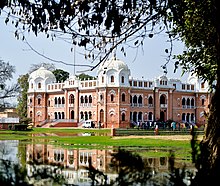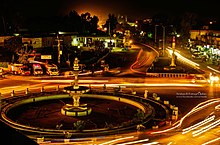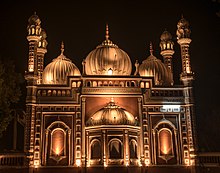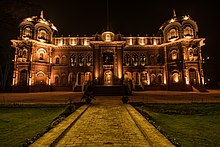Bahawalpur
Bahawalpur
بہاول پور | |
|---|---|
UTC+5 (PKT) | |
| Postal code type | 63100 |
| Area code | 062 |
| Website | Bahawalpur / Punjab Portal |
Bahawalpur (/bəha:wəlpʌr/; Punjabi, Urdu: بہاول پور, romanized: Bahāwalpūr; pronounced [bəɦɑːʋəlpuːɾ]) is a city in the Punjab province of Pakistan. It is one of the ten largest cities of Pakistan and 6th most populous city of Punjab.[6] Bahawalpur is the capital of Bahawalpur Division.
Founded in 1748, Bahawalpur was the capital of the former princely state of Bahawalpur, ruled by the Abbasi family of Nawabs until 1955. The Nawabs left a rich architectural legacy, and Bahawalpur is known for its monuments dating from that period.[7] The city lies at the edge of the Cholistan Desert, and serves as the gateway to the nearby Lal Suhanra National Park.
History
Bahawalpur was among the 584 princely states before the Partition of India.[8]


Early history
Bahawalpur State was home to various ancient societies. The Bahawalpur region was part of Multan province of
Establishment
Bahawalpur was established in 1748 by Nawab Bahawal Khan I,[15] after he migrated to the region around Uch from Shikarpur, Sindh.[16] Bahawalpur replaced Derawar as the clan's capital city.[17] The city initially flourished as a trading post on trade routes between Afghanistan and central India.[18]
Durrani Attacks
In 1785, the Durrani commander Sirdar Khan attacked Bahawalpur city and destroyed many of its buildings on behalf of Mian Abdul Nabi Kalhora of Sindh.[19] Bahawalpur's ruling family, along with nobles from nearby Uch, were forced to take refuge in the Derawar Fort, where they successfully repulsed further attacks.[19] The attacking Durrani force accepted 60,000 rupees as nazrana or tribute, though Bahawal Khan later had to seek refuge in the Rajput states as the Afghan Durranis occupied Derawar Fort.[19] Bahawal Khan returned to conquer the fort by way of Uch, and re-established control of Bahawalpur.[19]
Princely state



The princely state of Bahawalpur was founded in 1802 by Nawab Mohammad Bahawal Khan II after the break-up of the Durrani Empire, and was based in the city.
Sikh Attacks and treaties with the British
In 1807, Ranjit Singh of the Sikh Empire laid siege to the fort in Multan, prompting refugees to seek safety in Bahawalpur in the wake of his marauding forces that began to attack the countryside around Multan.[19] Ranjit Singh eventually withdrew the siege, and gave the Nawab of Bahawalpur some gifts as the Sikh forces retreated.[19]

Bahalwapur offered an outpost of stability in the wake of crumbling Mughal rule and the declining power of
Fearing an invasion from the Sikh Empire,
Trade Routes
Trade routes had shifted away from Bahawalpur by the 1830s, and British visitors to the city noted several empty shops in the city's bazaar.
Increased British Influence
An 1866 crisis over succession to the Bahawalpur throne markedly increased British influence in the princely state.[22] Bahawalpur was constituted as a municipality in 1874.[23] Bahalwapur's Nawab celebrated the Golden Jubillee of Queen Victoria in 1887 in a state function at the Noor Mahal palace.[21] In 1901, the population of the city was 18,546.[17]
The Second World War
At the outbreak of World War II in 1939, Bahawalpur's Nawab was the first ruler of a princely state to offer his full support and resources of the state towards the crown's war efforts.[24]
Joining Pakistan
British Princely states were given the option to join either Pakistan or
District statistics
There are 6 tehsils in District Bahawalpur, with 109
Climate
Bahawalpur lies some 117 metres or 384 feet above sea level. The climate is dry. Over the year, there is virtually no rainfall in Bahawalpur. According to the
Flora and Fauna
Flora
- Kikar
- Shisham
- Sufaida
- Neem
- Siris
- Toot
- Sohanjana
Fauna
Economy

The main crops for which Bahawalpur is recognised are
Crafts
Bahawalpur is famous for its carpets, embroidery, and pottery. The Punjab government has set up a Craft Development Centre from where handicrafts can be purchased. These handicrafts are mostly manufactured in the Cholistan area.[28] Following is the list of some of the mementos manufactured in the city:
- Flassi: It is made up of camel hair and can be used as a carpet or wall hanging
- Gindi: A colourful combination of cotton cloth with delicate needlework. It can be used as a blanket, carpet, or bed cover
- Changaries: Made up of palm leaves. They can be used as a decorative wall hanging or can be used to store chapatis / wheat bread
- Khalti: A kind of purse with multi-coloured threadwork
- Artwork: Special traditional embroidery done on kurta, chaddar/shawl etc
Demographics
According to the
| Year | Pop. | ±% |
|---|---|---|
| 1941 | 40,000 | — |
| 1951 | 42,000 | +5.0% |
| 1961 | 84,000 | +100.0% |
| 1972 | 134,000 | +59.5% |
| 1981 | 180,000 | +34.3% |
| 1998 | 408,395 | +126.9% |
| 2017 | 762,111 | +86.6% |
Religion

Bahawalpur emerged as a centre of
| Religious group |
1881[32][33]: 520 [34]: 250 | 1891[35]: 68 [36] | 1901[37]: 44 [38]: 26 | 1911[39]: 23 [40]: 19 | 1921[41]: 25 [42]: 21 | 1931[43]: 26 | 1941[31]: 32 | 2017[44] | ||||||||
|---|---|---|---|---|---|---|---|---|---|---|---|---|---|---|---|---|
| Pop. | % | Pop. | % | Pop. | % | Pop. | % | Pop. | % | Pop. | % | Pop. | % | Pop. | % | |
| Islam |
7,459 | 54.7% | 11,109 | 59.36% | 11,161 | 60.18% | 11,395 | 61.88% | 12,042 | 65.11% | 13,735 | 65.58% | 28,946 | 72.34% | 776,135 | 98.24% |
| Hinduism |
6,082 | 44.61% | 7,450 | 39.81% | 7,236 | 39.02% | 6,879 | 37.36% | 6,363 | 34.41% | 7,166[b] | 34.22% | 10,836[b] | 27.08% | 2,018 | 0.26% |
| Jainism |
48 | 0.35% | 0 | 0% | 0 | 0% | 0 | 0% | 0 | 0% | 0 | 0% | 0 | 0% | — | — |
| Sikhism |
43 | 0.32% | 147 | 0.79% | 135 | 0.73% | 126 | 0.68% | 75 | 0.41% | 29 | 0.14% | 208 | 0.52% | — | — |
| Christianity |
— | — | 10 | 0.05% | 14 | 0.08% | 14 | 0.08% | 14 | 0.08% | 12 | 0.06% | 25 | 0.06% | 11,615 | 1.47% |
| Zoroastrianism |
— | — | 0 | 0% | 0 | 0% | 0 | 0% | 0 | 0% | 1 | 0% | — | — | — | — |
| Ahmadiyya |
— | — | — | — | — | — | — | — | — | — | — | — | — | — | 265 | 0.03% |
| Others | 3 | 0.02% | 0 | 0% | 0 | 0% | 0 | 0% | 0 | 0% | 0 | 0% | 0 | 0% | 31 | 0% |
| Total population | 13,635 | 100% | 18,716 | 100% | 18,546 | 100% | 18,414 | 100% | 18,494 | 100% | 20,943 | 100% | 40,015 | 100% | 790,064 | 100% |
Civic administration
Bahawalpur was announced as one of six cities in Punjab whose security would be improved by the
Infrastructure

- The city's Noor Mahal palace was completed in 1875.[17]
- In 1878, the 4,285-foot (1,306 m) long Empress Bridge was constructed as the first rail crossing over the Sutlej River.[17]
- Two hospitals were established in the city in 1898.[17]
- The Bahawal Stadium or (formerly) The Bahawalpur Dring Stadium.
- The Darbar Mahal was built in 1905.
- The Gulzar Mahal
Bahawalpur Museum
The Bahawalpur Museum, established in 1976, is a museum of archaeology, art, heritage, modern history, and religion. It comes under the control of the Bahawalpur district government.[47] The current director of the museum is Hussain Ahmed Madni. It has eight galleries:
- Pakistan Movement gallery
- Archaeological gallery
- Islamic gallery; manuscripts, inscriptions, and Quranic documents
- Cultural heritage gallery
- Art gallery
- Coins gallery
- Cholistan gallery
- Nawab Bahawal Memorial gallery
Bahawalpur Zoo
The Bahawalpur Zoo, established in 1942, is a 25-acre (10 ha) zoological garden. It is managed by the Government of Pakistan.[48]
The zoo has occasionally bred and supplied wild cats, such as Asiatic lions and Bengal tigers, to other zoos in the country. It also has an aquarium and zoological museum with stuffed birds, reptiles, and mammals. The Bahawalpur Zoo is the fourth biggest zoo in Pakistan, after Lahore Zoo, Karachi Zoo and Islamabad Zoo.
Railway Station
- Bahawalpur Railway Station is located in Bahawalpur city at an elevation of 117 metres. It is one of the major railway stations of Pakistan Railways on the Karachi-Peshawar main line.
- The station is staffed and has advance and current reservation offices.
- In 2016, the Railways Minister Khawaja Saad Rafique announced that PKR. 280 million will be spent on the construction of a Model Railway Station in Bahawalpur.
- The routes linked Bahawalpur to the cities of Karachi, Lahore, Rawalpindi, Peshawar, Quetta, Multan, Faisalabad, Sargodha, Sialkot, Gujranwala, Hyderabad, Sukkur, Jhang, Rahim Yar Khan, Nawabshah, Attock, Sibi, Khanewal, Gujrat, Rohri, Jacobabad, and Nowshera.
Lal Suhanra National Park
Lal Suhanra is a national park in Pakistan. The park itself is situated some 35 kilometres east of Bahawalpur. It is one of South Asia's largest national parks and is a UNESCO declared Biosphere Reserve. Lal Sohanra is notable for the diversity of its landscape, which includes desert, forest, and wetland ecosystems.[49]
Education

Bahawalpur's
Transportation
Local transportation vehicles include buses, cars, motorbikes, and rickshaws.
N-5
Pakistan's longest national highway, N-5, also passes through the city, connecting Bahawalpur to Karachi and Lahore.[51]
Railroad
The railway connects Bahawalpur with the cities of Karachi, Lahore, Rawalpindi, Peshawar, Quetta, Multan, Faisalabad, Sargodha, Sialkot, Gujranwala, Hyderabad, Sukkur, Jhang, Rahim Yar Khan, Nawabshah, Attock, Sibi, Khanewal, Gujrat, Rohri, Jacobabad, and Nowshera.[51]
Sports
Notable people
- Film snd television actor Art Malik, was born in the city
- Former field hockey player, Samiullah Khan, was born in the city[53]
- Former journalist, presenter and producer at the BBC World Service, Durdana Ansari, OBE, was born in the city
- Pakistani footballer, Muhammad Adil
- Former Member of National Assembly Nawab Salahuddin Abbasi
- Member of the Provincial Assembly of Punjab, Samiullah Chaudhary
- Former member of the National Assembly of Pakistan Ch.Tariq Bashir Cheema]]
- Disabled Cricket Team Player, Muhammad Zubair Saleem
- Television and theater actor and writer, Saqib Sameer
- Member of National Assembly of Pakistan, Muhammad Farooq Azam Malik
- Mastana – Murtaza Hassan, Pakistani comedian and stage actor
See also
- Bahawalpur Museum
- Bahawalpur Zoo
- List of educational institutions in Bahawalpur
- List of people from Bahawalpur
Notes
- ^ 1891-1941: Data for the entirety of the town of Bahawalpur, which included Bahawalpur Municipality.[31]: 32
2017: Combined urban populations of Bahawalpur City Tehsil and Bahawalpur Saddar Tehsil. - ^ a b 1931-1941: Including Ad-Dharmis
References
- ^ "Administrators' appointments planned as Punjab LG system dissolves today". The Nation (newspaper). 31 December 2021. Retrieved 6 January 2022.
- ^ "Four injured as false ceiling in church building collapses". Dawn (newspaper). 26 December 2023. Retrieved 30 December 2023.
- ^ "MC Bahawalpur". MC Bahawalpur. Archived from the original on 26 April 2018. Retrieved 25 April 2018.
- ^ "Pakistan: Tehsils and Talukas (Districts and Subdistricts) – Population Statistics, Charts and Map".
- ^ "DISTRICT AND TEHSIL LEVEL POPULATION SUMMARY WITH REGION BREAKUP: PUNJAB" (PDF). Pakistan Bureau of Statistics. 3 January 2018. Archived from the original (PDF) on 25 April 2018. Retrieved 24 April 2018.
- ^ a b "Pakistan: Provinces and Major Cities – Population Statistics, Maps, Charts, Weather and Web Information".
- ISBN 9780195473537.
- JSTOR 40106322.
- ^ "A century later, Bahawalpur's Darbar Mahal stands tall – The Express Tribune". 21 April 2017.
- ISBN 978-969-407-226-5.
- ^ Auj, Nūruzzamān (1987). Ancient Bahawalpur. Caravan Book Centre.
- ISBN 9788170222484.
- ^ North Indian Inscriptions volume III: Inscriptions of the Early Gupta Kings. p. 23.
- ^ "UNESCO Office in Bangkok: Uch Monument". unescobkk.org. Archived from the original on 23 January 2018. Retrieved 26 January 2018.
- ISBN 9788120619654.
- ISBN 9780520285293.
- ^ a b c d e f Cotton, James Sutherland; Burn, Sir Richard; Meyer, Sir William Stevenson (1908). Imperial Gazetteer of India ... Clarendon Press.
- ^ a b c d e The Asiatic Journal and Monthly Register for British India and Its Dependencies. Black, Parbury, & Allen. 1838.
- ^ a b c d e f g h i j Álī, Shahāmat (1848). The History of Bahawalpur: With Notices of the Adjacent Countries of Sindh, Afghanistan, Multan, and the West of India. James Madden.
- ^ ISBN 9781442241480.
- ^ a b bahādur.), Muḥammad Laṭīf (Saiyid, khān (1891). History of the Panjáb from the Remotest Antiquity to the Present Time. Calcutta Central Press Company, limited.
{{cite book}}: CS1 maint: multiple names: authors list (link) - ISBN 9781598846591.
- ^ "Bahawalpur | Pakistan". Encyclopædia Britannica. Retrieved 26 January 2018.
- ^ Javaid, Umbreen (2004). Politics of Bahawalpur: From State to Region, 1947–2000. Classic.
- ^ "Our History | Bahawalpur". bahawalpur.punjab.gov.pk. Retrieved 17 November 2021.
- ^ "Climate | Bahawalpur". bahawalpur.punjab.gov.pk. Retrieved 17 November 2021.
- ^ "Punjab Portal". Archived from the original on 3 September 2010. Retrieved 17 September 2009.
- ^ "The People | Bahawalpur". bahawalpur.punjab.gov.pk. Retrieved 17 November 2021.
- ISBN 9781316338872.
- ^ "St. Dominic's Church | Bahawalpur". bahawalpur.punjab.gov.pk. Retrieved 17 November 2021.
- ^ a b "CENSUS OF INDIA, 1941 VOLUME VI PUNJAB". Retrieved 9 January 2024.
- JSTOR saoa.crl.25057656. Retrieved 14 January 2024.
- JSTOR saoa.crl.25057657. Retrieved 14 January 2024.
- JSTOR saoa.crl.25057658. Retrieved 20 January 2024.
- JSTOR saoa.crl.25318666. Retrieved 9 January 2024.
- JSTOR saoa.crl.25318669. Retrieved 9 January 2024.
- JSTOR saoa.crl.25352838. Retrieved 9 January 2024.
- JSTOR saoa.crl.25363739. Retrieved 9 January 2024.
- JSTOR saoa.crl.25393779. Retrieved 9 January 2024.
- JSTOR saoa.crl.25393788. Retrieved 9 January 2024.
- JSTOR saoa.crl.25394121. Retrieved 9 January 2024.
- JSTOR saoa.crl.25430165. Retrieved 9 January 2024.
- ^ "CENSUS OF INDIA, 1931 VOLUME XVII PUNJAB PART II TABLES". Retrieved 9 January 2024.
- ^ "Final Results (Census-2017)". Retrieved 27 January 2023.
- ^ "After Lahore, six others to become 'safer cities'". Express Tribune. 20 February 2017. Retrieved 23 February 2017.
- ^ "Punjab Safe City Project inaugurated". Dawn. 12 October 2016. Retrieved 23 February 2017.
- ^ "Bahawalpur Museum | Bahawalpur". bahawalpur.punjab.gov.pk. Retrieved 17 November 2021.
- ^ "Bahawalpur Zoo | Bahawalpur". bahawalpur.punjab.gov.pk. Retrieved 17 November 2021.
- ^ "Lal Suhanra National Park | Bahawalpur". bahawalpur.punjab.gov.pk. Retrieved 17 November 2021.
- ^ "District Profile | Bahawalpur". bahawalpur.punjab.gov.pk. Retrieved 17 November 2021.
- ^ a b "Transportation | Bahawalpur". bahawalpur.punjab.gov.pk. Retrieved 17 November 2021.
- ^ "Bahawal Stadium | Pakistan | Cricket Grounds | ESPNcricinfo.com". ESPNcricinfo. Retrieved 17 November 2021.
- ^ "Samiullah Khan". PrideOfPakistan.com. 6 September 1951. Retrieved 23 August 2022.
Bibliography
- Moj, Muhammad (2015), The Deoband Madrassah Movement: Countercultural Trends and Tendencies, Anthem Press, ISBN 978-1-78308-389-3
- Talbot, Ian (2015), "Introduction", in Roger D. Long; Gurharpal Singh; Yunas Samad; Ian Talbot (eds.), State and Nation-Building in Pakistan: Beyond Islam and Security, Routledge, pp. 1–, ISBN 978-1-317-44820-4
- ISBN 978-1-85065-704-0.
External links
 Bahawalpur travel guide from Wikivoyage
Bahawalpur travel guide from Wikivoyage- Bahawalpur at Curlie

